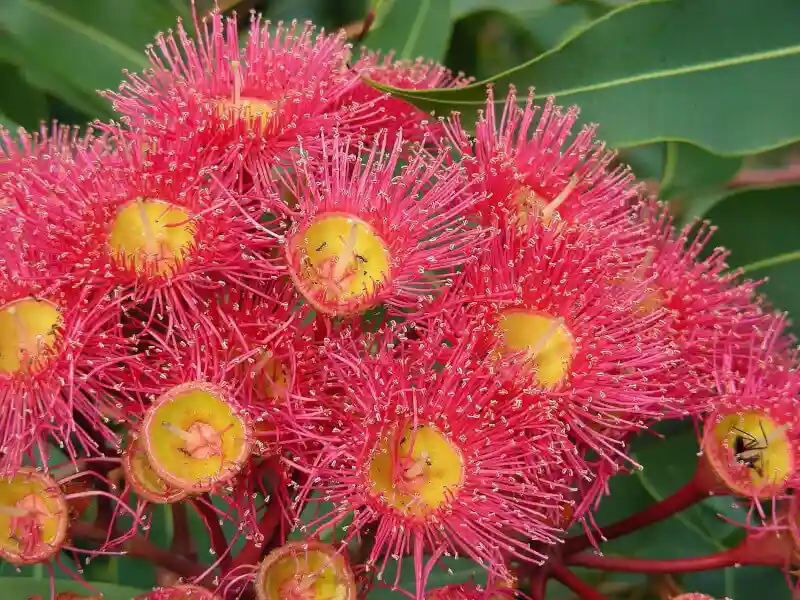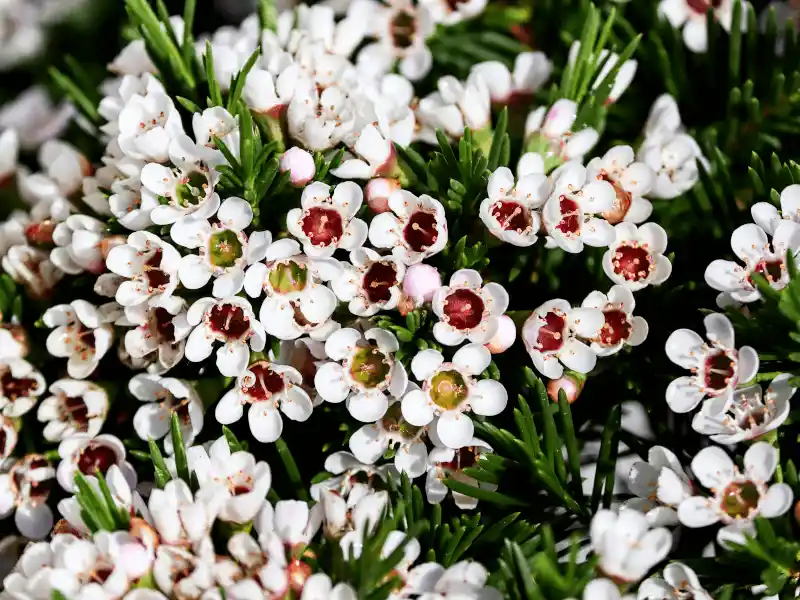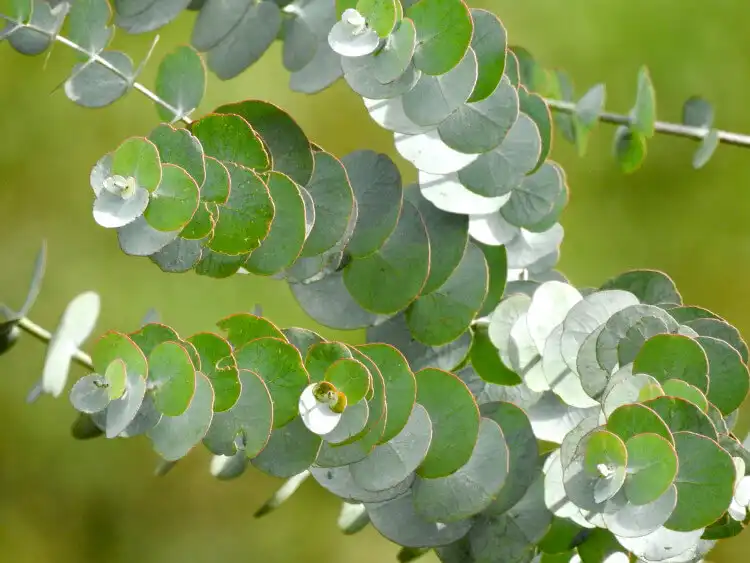
IN THIS ARTICLE
Overview
Eucalyptus trees are widely admired for their aromatic foliage, stunning bark, and ability to attract wildlife. However, many species can grow into towering giants, making them unsuitable for small gardens or urban landscapes.
Fortunately, several miniature eucalyptus trees – species that stay compact for life, typically remaining under 3 – 4 metres in height – offer all the beauty and benefits of eucalyptus without the size concerns.
Some of these trees are resilient species in arid and semi-arid regions of Australia, while others are found in highlands where growing conditions are tough. All of them are highly adaptable to drought and nutrient-poor soils.
If you prefer taller varieties with 4 – 8 metres in height, check out this article on small eucalyptus trees.

Why choose miniature eucalyptus trees?
Miniature eucalyptus trees offer a range of benefits, making them an excellent choice for gardeners who love to get close to them and enjoy the unique qualities that each species brings. Here are some key reasons to consider them:
Perfect for small spaces
Many home gardeners struggle with space limitations, especially in urban and suburban settings. Miniature eucalyptus trees provide striking form, foliage, and blooms like their larger relatives while staying manageable. They fit well in courtyards, patios, terraces, balconies, and compact gardens.
Live sculpture
Miniature eucalyptus trees often form attractive trunks and intricate branching structures. Many feature smooth, peeling bark that reveals beautiful underlying colours, while others develop gnarled or twisted stems, adding character and texture to their environment.
Attractive foliage
Miniature eucalyptus trees are diverse in their foliage. With a unique combination of colour, texture, shape, and form for each species, there is no shortage of magnificence in foliage display. Miniature eucalyptus trees work beautifully as ornamental focal points, low hedges, or screening plants.
Stunning flowers
Beyond their foliage, most miniature eucalyptus trees produce showy, nectar-rich flowers that attract bees, butterflies, and birds. Their bright yellow, white, pink, or red blooms emerge in clusters and contrast beautifully against their leaves.
Low maintenance
Most eucalyptus species, including the miniature varieties, are remarkably drought-resistant once established. They require minimal maintenance, making them ideal for gardeners looking for low-water, low-effort plant options.
Adaptable to pots and containers
Since miniature eucalyptus trees remain small, they can be easily grown in pots or containers. This makes them a great option for renters or people who need to relocate their plants when necessary.
Versatile uses
Whether in urban courtyards or rural landscapes, miniature eucalyptus trees seamlessly integrate into diverse planting schemes, offering year-round visual interest. Their compact size and distinctive foliage allow them to serve as striking feature plants, screening hedges, or standalone shrubs.
Miniature eucalyptus trees
1. Eucalyptus kruseana (Bookleaf Mallee)
Eucalyptus kruseana stands out with its unique appearance. Its distinctive, rounded, silvery-blue leaves are tightly arranged in pairs along the branch, resembling book pages.
At a modest height of 2 – 3 metres, this Bookleaf Mallee is uniquely adapted to thrive in the nutrient-poor, arid landscapes of Western Australia. It has a resilient growth nature with high tolerance to both drought and frost. Its multi-stemmed form and straggly branches create a sculptural delight in any garden.
When in bloom, small clusters of delicate yellow flowers attract native pollinators. Regular pruning will allow you to shape the plant and achieve a denser form, and the cut foliage can be used for an indoor display.
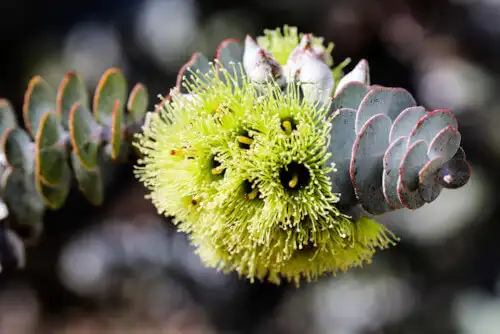
2. Eucalyptus preissiana (Bell-fruited Mallee)
Bell-fruited Mallee is prized for its bright yellow flowers and beautiful elliptical and spear-shaped blue-green foliage. Often developing a compact, shrubby form, it is highly suitable for pots and small gardens.
Native to the southwest coast of Western Australia, the Bell-fruited Mallee thrives in sandy, well-drained soils. It displays an open, spreading, multi-stemmed form with smooth bark. The massive blooms are a magnet to attract native pollinators.
Growing to around 1.5 – 3 metres, it exhibits steady, moderate growth, ideal for formal courtyard settings. Bell-fruited Mallee prefers a temperate climate and is well-suited to coastal regions. While it is drought-hardy, it can only tolerate occasional frost.
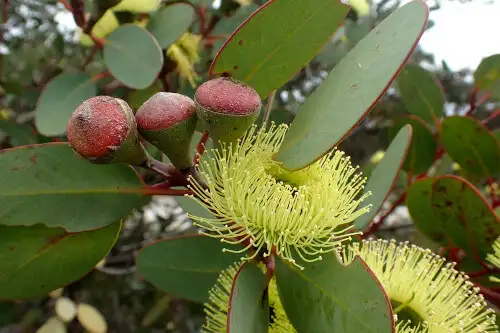
3. Eucalyptus synandra (Jingymia Mallee)
Jingymia Mallee is a rare Eucalyptus species. This fast-growing tree is celebrated for its unique cascading branches, smooth sculptural trunk, and exquisite bell-shaped flowers. Native to the semi-arid region of Western Australia, it prefers a warm, dry climate with hot summers and cool winters.
Growing to 2 – 4 metres, it exhibits an open, multi-stemmed habit with a trunk of smooth, light grey bark that peels in delicate ribbons. Its foliage is narrow, linear, slightly sickle-shaped, and pale green. Clusters of bell-shaped cream or pink flowers appear from late spring through summer.
Jingymia Mallee is drought-hardy, moderately frost-tolerant, and highly adaptable to poor and heavy soils. Its graceful form and organic softness are highly desirable in relaxed, sustainable landscape designs.
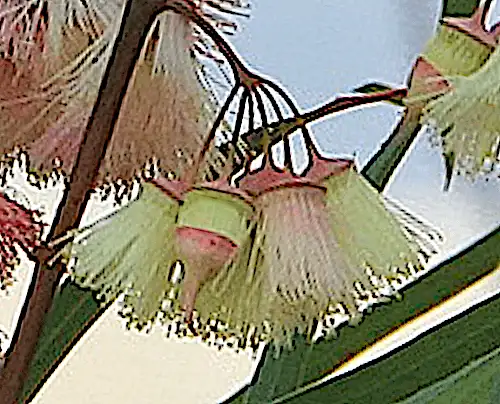
4. Eucalyptus pimpiniana (Pimpin Mallee)
Eucalyptus pimpiniana, or Pimpin Mallee, is a compact mallee distinguished by its stunning spear-shaped, pastel grey-green foliage and eye-catching bright yellow flowers.
Indigenous to arid zones in South Australia and Western Australia, this plant is well adapted to hot and dry climates, with moderate frost tolerance. This mallee can be a single or multi-stemmed sprawling shrub that grows 1 – 3 metres tall.
Like many other miniature eucalyptus trees, Pimpin Mallee thrives in well-drained, sandy, or gravelly soils, making it highly suitable for container planting. It is an excellent plant for habitat restoration in drought-prone areas.

5. Eucalyptus albida (White-leaved Mallee)
Eucalyptus albida, or White-leaved Mallee, is best known for its stunning silvery-blue juvenile foliage, which makes it highly desirable in ornamental gardening. Its adult leaves, in contrast, are very different – deep green and lance-shaped.
A compact, smooth-barked mallee native to southwestern Western Australia, White-leaved Mallee thrives in coastal and semi-arid climates with mild winters and hot, dry summers. It is highly adaptable to nutrient-poor, sandy, gravelly, and degraded soils, so long as they are well-drained.
White-leaved Mallee is often kept as a low-growing, multi-stemmed shrub to keep its attractive juvenile foliage. Left unpruned, it can quickly develop into an adult form and reach 2 – 4 metres in height. White-leaved Mallee is ideal for both inland and coastal gardens.

6. Eucalyptus grossa (Coarse-leaved Mallee)
Eucalyptus grossa, or Coarse-leaved Mallee, commands attention with its rugged charm. Its distinctive thick, broad, glossy, leathery, spade-shaped foliage, rough fibrous stems, and magnificent large yellow-green flowers all contribute to its quality.
Endemic to arid regions of Western Australia, Eucalyptus grossa thrives in hot, dry climates with minimal rainfall and is drought and frost-hardy. It often develops into a straggly, multi-stemmed tree to 1.5 to 4 metres, with rough, fibrous bark near the base transitioning to smooth bark above.
Coarse-leaved Mallee can be pruned to maintain a compact shape. It is highly adaptable to various nutrient-poor soil types and is ideal for modern rustic landscapes with water-wise designs.

7. Eucalyptus minniritchi
A fascinating small mallee species native to Western Australia, Eucalyptus minniritchi is named for its distinctive peeling “minni ritchi” bark, which sheds in thin, curly strips to reveal a striking red underlayer.
Eucalyptus minniritchi is endemic to Central Australia. It thrives in poor, sandy or gravelly soils under hot and dry conditions. Growing to 2 to 3 metres, it is drought-hardy and moderately tolerant of frost.
Its foliage features egg- or heart-shaped, elliptical leaves in a blue-green shade, giving the plant a delightful appearance. In spring, rounded or teardrop-shaped buds & creamy-white to pale yellow flowers in clusters emerge.
With a spreading form and dense growth, Eucalyptus minniritchi is ideal for an informal hedge, privacy screening, or a feature specimen in a native garden.
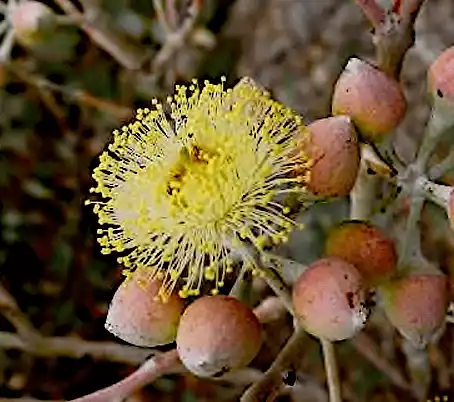
8. Eucalyptus vernicosa (Varnish Gum)
Eucalyptus vernicosa, or Varnished Gum, is perhaps the smallest eucalyptus species, featuring a refined appearance of glossy, deep-green leaves and smooth, mottled bark. White flowers emerge in summer, attracting birds and pollinators.
Native to the highlands of Tasmania, Varnish Gum thrives in cool, temperate climates with moderate rainfall. It rarely reaches a height of 1 metre and only stays as a small, dense shrub. Varnish Gum is frost–hardy and flourishes in well-drained, slightly acidic soils typical of its native habitat.
While Varnish Gum is a mallee, it is ideal for cool-climate gardens and container growing. Its dense foliage and shrubby growth are perfect for a low hedge. Because of its wind resistance, it is a great choice for exposed coastal and alpine environments.
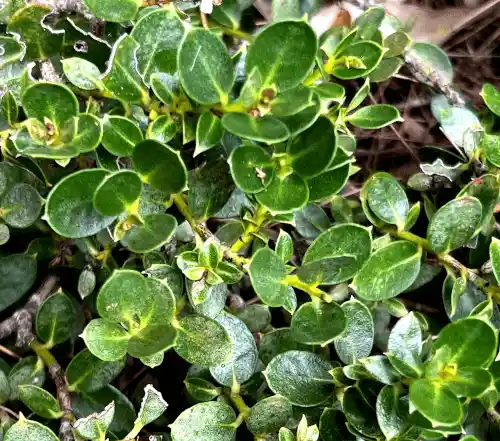
9. Eucalyptus pulverulenta ‘Baby Blue’
Eucalyptus pulverulenta ‘Baby Blue’, a slow-growing variety of Eucalyptus pulverulenta, is a rare mallee prized for its striking straggly silvery-blue foliage, widely used in floral arrangements.
Its acclaimed juvenile foliage persists through maturity. These leaves grow in opposite pairs along the branch, giving the tree its signature look.
Native to southeastern Australia, it flourishes in temperate climates with dry summers and mild winters. It can grow to 2 to 3 metres.
Its resistance to drought makes it well-suited to dry gardens. While this plant is ideal for pots, it does have a sprawling habit. Regular pruning will keep the plant in shape, while the cut branches can be used for the floral display.
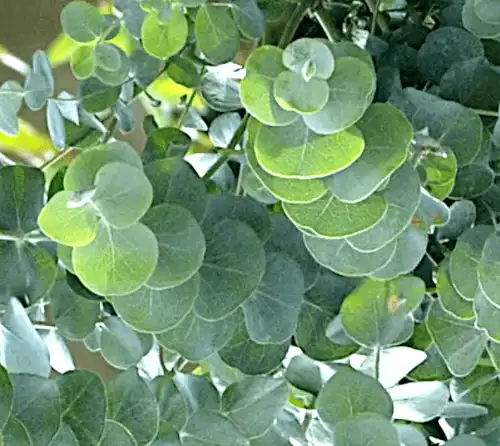
11. Eucalyptus tetraptera (Square-fruited Mallee)
Eucalyptus tetraptera, or Square-fruited Mallee, is noted for its unique pink-red geometric buds and broad, thick, glossy, lance-shaped leaves with vibrant reddish twigs.
Square-fruited mallee is a striking small eucalyptus endemic to southern Western Australia. It thrives in a Mediterranean climate with hot, dry summers and mild, wet winters. Typically growing to 1.5 to 4 metres, it develops smooth, greyish, straggly stems.
The spectacular fruit-like flowers emerge from late winter to mid-summer, attracting birds and pollinators alike. Its geometric appeal and sculptural form are ideal for waterwise minimalist gardens in drought-prone regions.
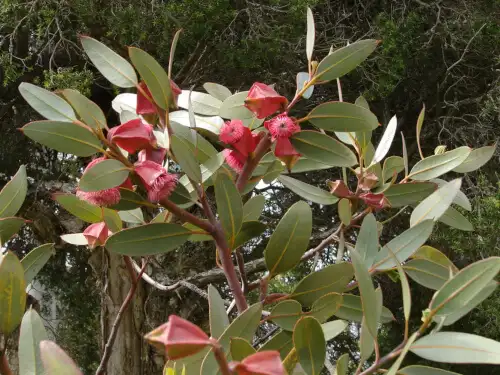
12. Eucalyptus gunnii ‘France Bleu’
‘France Bleu’ is a compact, ornamental cultivar of Eucalyptus gunnii, celebrated for its striking foliage and compact form. The juvenile plant has attractive, round, grey, or blue-green leaves. Its foliage becomes finer and more elliptical at maturity, with a lightly textured, graceful appearance.
Native to Tasmania, Eucalyptus gunnii thrives in cool, temperate climates with wet winters and mild summers. As a cool-climate mallee, it is both drought- and frost-hardy. ‘France Bleu’ is a dwarf variety derived from France and is currently not available in Australia.
Eucalyptus gunnii ‘France Bleu’ imparts a soothing quality to any outdoor space, with a fine, dense canopy and smooth bark. It is perfect for container planting in small gardens, patios, terraces, or balconies. Its frost tolerance is a highly desirable attribute for alpine gardens.

13. Eucalyptus ‘Moon Lagoon’
Eucalyptus ‘Moon Lagoon’ is a natural hybrid of two mallee species from Western Australia. It is highly valued for its striking, silvery-blue, spade- or spear-shaped juvenile foliage. As the tree matures, it develops a multi-stemmed habit with smooth, greyish bark and fine, dense, green adult leaves.
Unlike regular miniature eucalyptus trees, Moon Lagoon requires hard pruning to retain its juvenile form. Young shoots have a stunning purple-red hue, adding seasonal colour variation. If left unclipped, it can reach 2 – 3 metres tall. Small yellow flowers emerge in late winter, attracting bees and birds.
Moon Lagoon is excellent for low-maintenance gardens, ornamental screening, and cut foliage decoration. It thrives in well-drained soils and tolerates drought, making it ideal for arid and semi-arid gardens.
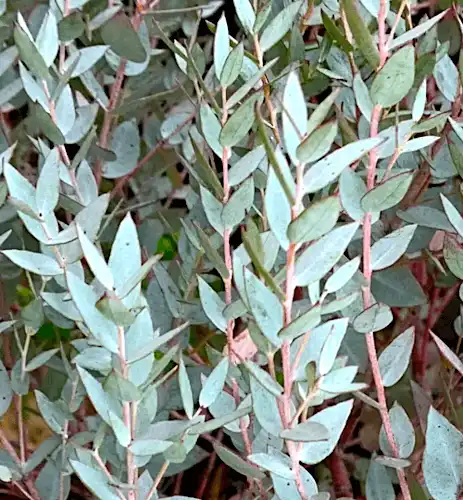
14. Eucalyptus rhodantha (Rose Mallee)
Eucalyptus rhodantha, or Rose Mallee, is a highly ornamental, spreading mallee endemic to Western Australia. It grows to 2 to 4 metres and features large, showy pink to red flowers with golden stamens, providing a vital nectar source for birds and bees.
Thick, silvery-grey, round, or heart-shaped leaves tightly alternate along straggly branches. Large flowers are incorporated within. The large bowl-shaped gumnuts are a significant ornamental feature following the blossom.
Rose Mallee is highly drought-tolerant and well-suited for native gardens and arid landscapes. With sprawling branches and smooth stems, it is an ideal feature plant that adds a delightful drama to your garden.
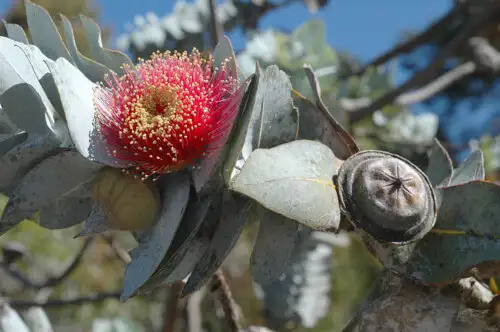
15. Eucalyptus macrocarpa (Mottlecah)
Eucalyptus macrocarpa, or Mottlecah, is a small mallee endemic to Western Australia. With a sprawling, low-growing habit and sculptural branches and foliage, it grows to 1.5 to 4 metres.
It produces huge, eye-catching blooms up to 10 cm in diameter, among the largest in eucalypts. These large, nectar-rich flowers are a huge attraction to birds and pollinators. Its foliage is unusual, greyish-white, waxy, teardrop-shaped, rounded, or elliptical and arranged in opposite pairs on either side of the branch.
Mottlecah requires minimal maintenance. With its striking leaves, flowers, and sculptural form, this plant makes a bold statement in any garden and offers many years of pleasure.
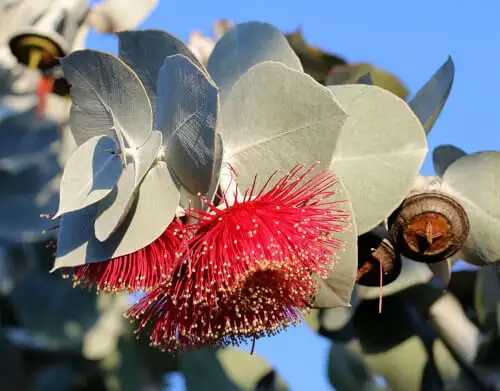
16. Eucalyptus macrocarpa x pyriformis (Nullarbor Rose)
Nullarbor Rose is a hybrid of Eucalyptus macrocarpa and Eucalyptus pyriformis. Both are mallee species endemic to Western Australia and produce eye-catching blooms.
Like its parental species, Nullarbor Rose is also a striking mallee that showcases large creamy-yellow, pink or red flowers. Its foliage is greyish-white, teardrop- or spear-shaped, and arranged in opposite pairs along the branch. However, leave pairs are more spaced apart, compared to Eucalyptus macrocarpa.
Nullarbor Rose grows to about 3 metres with a spreading and straggly habit. With stunning foliage, beautiful blooms and a sculptural form, it is a great feature plant that makes a bold statement.
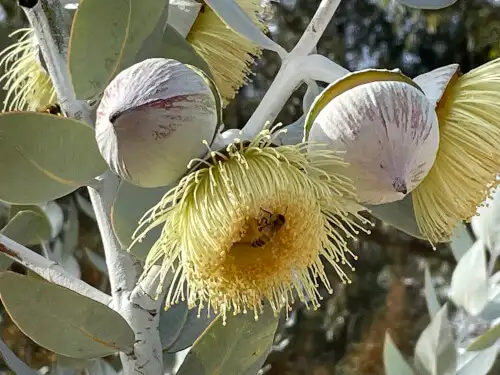
17. Eucalyptus cunninghamii (Cliff Mallee Ash)
The last but not the least species on the list of miniature eucalyptus trees is the Cliff Mallee Ash (Eucalyptus cunninghamii). It is an attractive, low-growing mallee featuring beautiful grey, smooth bark and willowy, narrow, lance-shaped, blue or grey-green leaves.
Native to the Blue Mountains of Australia, Cliff Mallee Ash frequently occurs on cliff edges or steep slopes. It is this growth habit that lends its name. It naturally thrives in nutrient-poor, sandy or stony soils with a cool temperate climate. It is drought-tolerant and frost-hardy.
Cliff Mallee Ash often grows to 2 metres, rarely 3 metres. It adopts a multi-stemmed, spreading form, with a rounded, dense canopy. This hardy and adaptable ornamental tree is well-suited to small gardens in temperate inland and coastal regions.
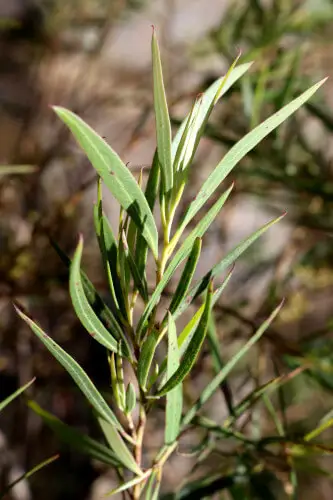
Final thoughts
From the stunning silver-blue foliage of Eucalyptus pulverulenta ‘Baby Blue’ to the bold and beautiful Eucalyptus Macrocarpa, miniature eucalyptus trees prove that small stature does not mean small impact. Each variety brings its unique qualities to elevate and enrich our gardens.
Their suitability for containers offers incredible value to people with limited outdoor space. Their ability to thrive in tough conditions with minimal care is ideal for those who desire a low-maintenance garden.
Whether you’re drawn to their lush foliage, sculptural forms, or beautiful blooms, these miniature eucalyptus trees are there to impress, with a touch of Australian charm!
FAQs
What is the smallest growing Eucalyptus?
Eucalyptus vernicosa (Varnish Gum) is perhaps the smallest eucalyptus tree known. It rarely grows over 1 meter.
Is there a dwarf Eucalyptus?
There are many dwarf eucalyptus species. Some are native, while others are hybrid. Most small eucalyptus species do not carry the word “dwarf” in their common names. In addition, there are dwarf flowering gums, which are artificially grafted Corymbia eucalypts.
What is the best Eucalyptus for a small garden?
Choosing the best small Eucalyptus tree for your garden requires some research. Determining what you would love the tree to do for you is the first step.
How compact would you like it to be? What purpose do you want it to serve? A feature tree, shade tree, or privacy screen? Which plant attributes do you focus on? And what about your climate and soil conditions?
Our articles on miniature and small eucalyptus trees can help you identify the species that suits you best based on your research.
